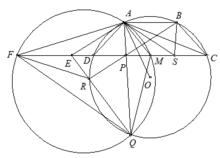Hãy nhập câu hỏi của bạn vào đây, nếu là tài khoản VIP, bạn sẽ được ưu tiên trả lời.

a) Giả sử điểm I thỏa mãn:
\(\overrightarrow{IA}+3\overrightarrow{IB}-2\overrightarrow{IC}=\overrightarrow{0}\)\(\Leftrightarrow\overrightarrow{IA}-\overrightarrow{IC}+\overrightarrow{IB}-\overrightarrow{IC}+2\overrightarrow{IB}=\overrightarrow{0}\)
\(\Leftrightarrow\overrightarrow{CA}+\overrightarrow{CB}+2\overrightarrow{IB}=\overrightarrow{0}\)
\(\Leftrightarrow2\overrightarrow{IB}=\overrightarrow{AC}+\overrightarrow{BC}\)
\(\Leftrightarrow\overrightarrow{IB}=\dfrac{\overrightarrow{AC}+\overrightarrow{BC}}{2}\).
Xác định véc tơ: \(\dfrac{\overrightarrow{AC}+\overrightarrow{BC}}{2}\).
A B C B' K
Dựng điểm B' sao cho \(\overrightarrow{BC}=\overrightarrow{CB'}\).
\(\overrightarrow{AC}+\overrightarrow{BC}=\overrightarrow{AC}+\overrightarrow{CB'}=\overrightarrow{AB'}\).
\(\dfrac{\overrightarrow{AC}+\overrightarrow{BC}}{2}=\dfrac{\overrightarrow{AB'}}{2}\).
Dựng điểm I sao cho \(\overrightarrow{IB}=\dfrac{\overrightarrow{AC}+\overrightarrow{BC}}{2}=\overrightarrow{AK}\) (K là trung điểm của AB').
A B C B' K I
b) Tìm điểm I sao cho: \(\overrightarrow{IA}+3\overrightarrow{IB}-2\overrightarrow{IC}=\overrightarrow{0}\) và chứng mịn điểm I cố định.
Có: \(\overrightarrow{IA}+3\overrightarrow{IB}-2\overrightarrow{IC}=\overrightarrow{IA}+3\overrightarrow{IB}+2\overrightarrow{CI}\)
\(=\left(\overrightarrow{CI}+\overrightarrow{IA}\right)+\left(\overrightarrow{CI}+\overrightarrow{IB}\right)+2\overrightarrow{IB}\)
\(=\overrightarrow{CA}+\overrightarrow{CB}+2\overrightarrow{IB}\).
Suy ra: \(\overrightarrow{CA}+\overrightarrow{CB}+2\overrightarrow{IB}=\overrightarrow{0}\)\(\Leftrightarrow\overrightarrow{IB}=\dfrac{\overrightarrow{AC}+\overrightarrow{BC}}{2}\)
Vậy điểm I xác định sao cho \(\overrightarrow{IB}=\dfrac{\overrightarrow{AC}+\overrightarrow{BC}}{2}\) .
Do A, B, C cố định nên tồn tại một điểm I duy nhất.
Theo giả thiết:
Có \(\overrightarrow{MN}=\overrightarrow{MA}+3\overrightarrow{MB}-2\overrightarrow{MC}\)\(=\overrightarrow{MI}+\overrightarrow{IA}+3\left(\overrightarrow{MI}+\overrightarrow{IB}\right)-2\left(\overrightarrow{MI}+\overrightarrow{IC}\right)\)
\(=2\overrightarrow{MI}+\overrightarrow{IA}+3\overrightarrow{IB}-2\overrightarrow{IC}\)
\(=2\overrightarrow{MI}\) (Do các xác định điểm I).
Vì vậy \(\overrightarrow{MN}=2\overrightarrow{MI}\) nên hai véc tơ \(\overrightarrow{MN},\overrightarrow{MI}\) cùng hướng.
Suy ra 3 điểm M, N, I thẳng hàng hay MN luôn đi qua điểm cố định I.

\(C\left(M;R\right)\) đi qua \(F_2\Rightarrow MF_2=R\) (1)
\(C\left(M;R\right)\) tiếp xúc trong với \(C_1\left(F_1;2a\right)\Rightarrow MF_1=2a-R\) (2)
(1) + (2) cho \(MF_1+MF_2=2a\)
Vậy M di động trên elip (E) có hai tiêu điểm là \(F_1,F_2\) và trục lớn \(2a\)


1). Gọi S điểm đối xứng với P qua M.Theo tính chất đối xứng của hình thang cân dễ thấy tứ giác ABSP cũng là hình thang cân.
Ta lại có Q P S ^ = Q A B ^ = Q R B ^ .
Từ đó có E P Q ^ = E R P ^ ⇒ Δ E R P ∽ Δ E P Q (g – g),
nên E Q P ^ = E P R ^ = B P S ^ = A S E ^ , suy ra tứ giác AEQS nội tiếp.
Do đó P A . P Q = P E . P S = P F 2 .2 P M = P F . P M , suy ra tứ giác A M Q F nội tiếp.
Từ đó suy ra đường tròn ngoại tiếp tam giác △ A Q F luôn đi qua M.